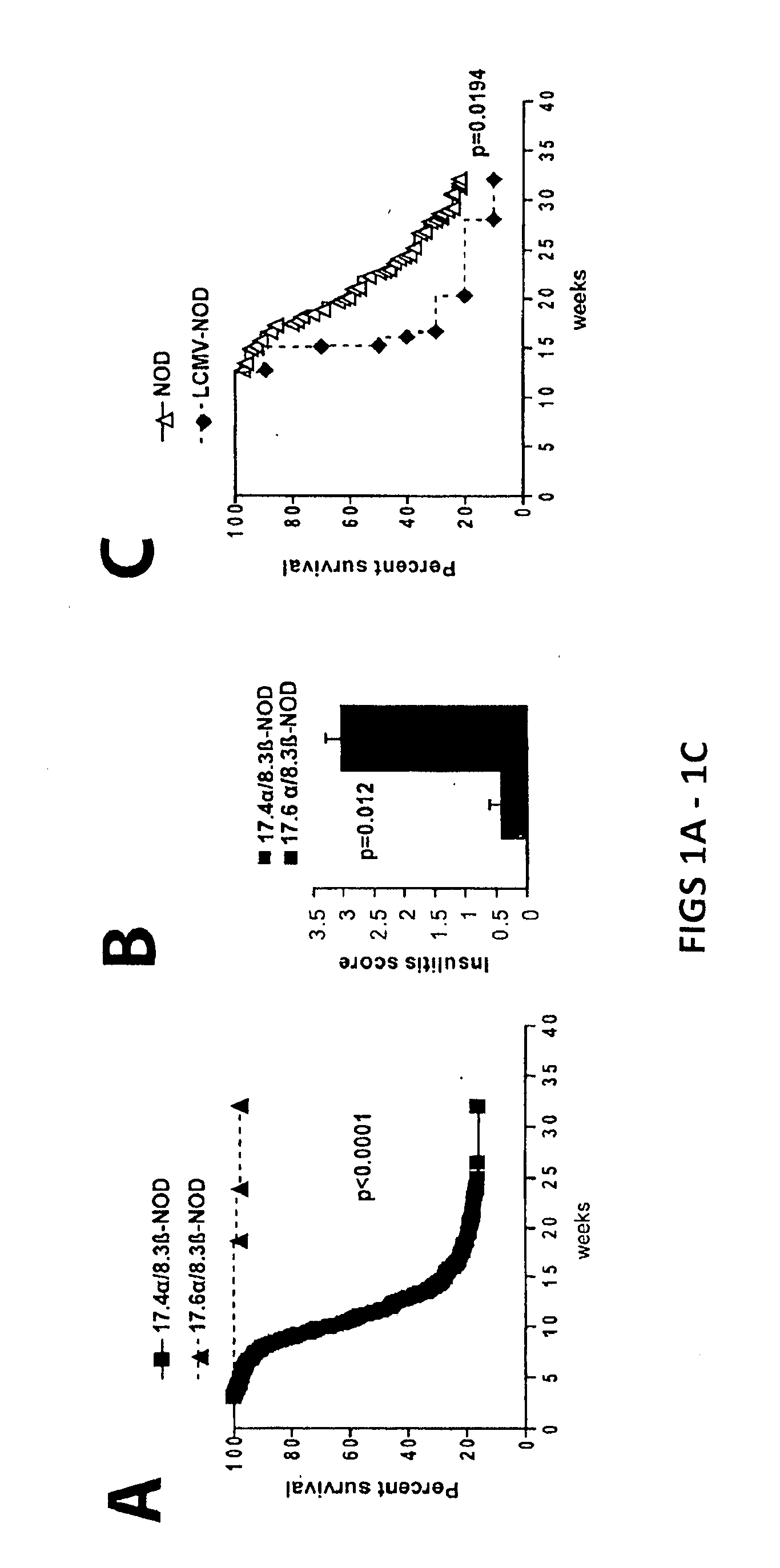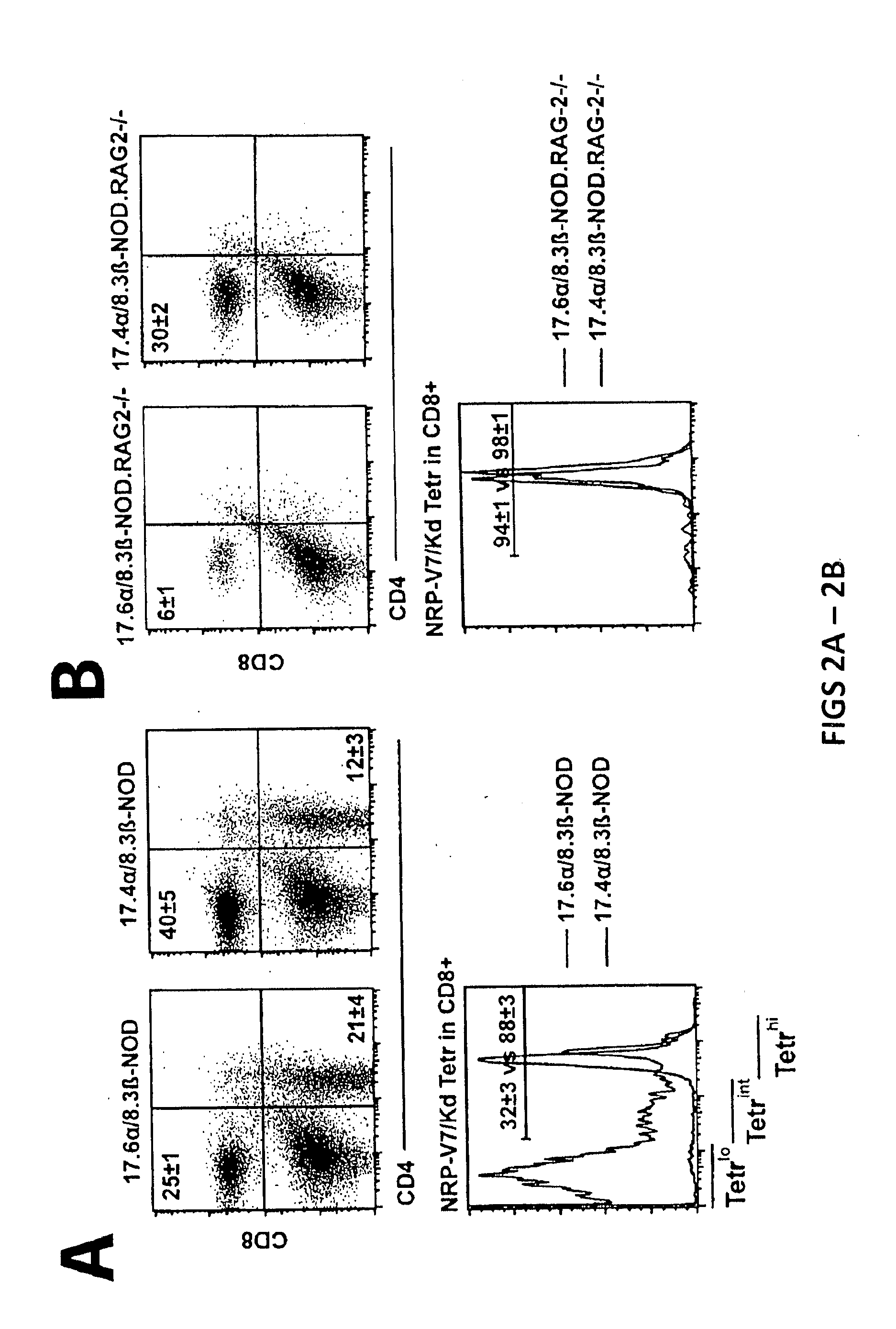Methods for treating autoimmune disease using biocompatible bioabsorbable nanospheres
a bioabsorbable nanosphere and autoimmune disease technology, applied in the field of immunology and medicine, can solve the problems of difficult treatment of patients with peptides, and achieve the effects of preventing, reducing, or reducing the number of functional cells
- Summary
- Abstract
- Description
- Claims
- Application Information
AI Technical Summary
Benefits of technology
Problems solved by technology
Method used
Image
Examples
example 1
[0173]T1D Protection by Treatment with Peptide / MHC-Coated Nanospheres
[0174]Diabetes protection by treatment with super-paramagnetic nanospheres coated with NRP-V7 / Kd monomers. To study whether NRP-V7 / Kd-coated nanospheres are tolerogenic in vivo, 8.3-TCR-transgenic NOD mice will be treated (also referred to as 8.3-NOD or Vα17.4+ TCR-TG mice further below) with several i.v. injections of a small volume of nanospheres (5 μl, carrying 0.6 μg of NRP-V7, once every 3 days). It is contemplated that the transgenic high-avidity IGRP206-214-reactive splenic CD8+ T-cell pools of these mice will be significantly depleted. It is also contemplated that the non deleted CD8+ T cells will be anergized by the treatment.
[0175]To study the effectiveness of ‘multiplexing’, nanospheres will be coated with 6 different peptide / MHC monomers. Cohorts of wild-type NOD mice will be treated with a pool of these nanospheres, with nanospheres coated with a control peptide (TUM) / Kd, or with nanospheres coated wit...
example 2
[0198]Testing the Ability of Iron Oxide Nanospheres Coated with Human Type 1 Diabetes-Relevant Peptide / HLA Complexes to Restore Normoglycemia
[0199]“Humanized” mice expressing HLA transgenes and peptide / HLA complexes available for the proposed studies. As mentioned above, peptides derived from insulin and IGRP are primary targets of CD8+ T cells in wild-type NOD mice. Assessment of human MHC molecules (Human Leukocyte Antigens, HLA) presented peptides derived from these two autoantigens during diabetogenesis is being investigated in ‘humanized’ HLA-transgenic NOD mice. Studies focused initially on HLAA*0201, a MHC molecule that is expressed by nearly 50% of certain ethnic groups. This study employs the strain designated NOD.β2 mnull.HHD, which lacks the murine β2 macroglobulin gene and expresses the chimeric monochain construct HHD (Pascolo et al., 1997). This construct encodes human β2m covalently linked to the α1 and α2 domains of human HLA-A*0201, and the α3, transmembrane, and cy...
example 3
Monospecific Peptide-MHC Class II-Coated Nanospheres
[0217]Production of T1D-relevant pMHC class II complexes. In order to test the hypothesis that nanospheres coated with T1D-relevant peptide / 1-Ag7 complexes could also afford T1D protection and cure T1D in NOD mice, several different peptide / 1-Ag7 complexes can be constructed from the following five T1D-relevant and control peptide sequences: BDC2.5 mimotope: AHHPIWARMDA (SEQ ID No. 59); IGRP128-145: TAALSYTISRMEESSVTL (SEQ ID No. 60); IGRP4-22: LHRSGVLIIHHLQEDYRTY (SEQ ID No. 61); IGRP195-214: HTPGVHMASLSVYLKTNVFL (SEQ ID No. 62); and Insulin B9-23: SHLVEALYLVAGERG (SEQ ID No. 63). As negative controls, G6P isomerase peptide (LSIALHVGFDH; SEQ ID No. 64) / 1-Ag7 complex (self pMHC control), and two hen egg lysozyme (HEL14-22-RHGLDNYRG; SEQ ID No. 65- and HEL11-25-AMKRHGLDNYRGYSL; SEQ ID No. 66-) / I-Ag7 complexes (foreign pMHC controls) can be used. Recombinant I-Ag7 monomers are generated as previously described. Briefly, the final con...
PUM
| Property | Measurement | Unit |
|---|---|---|
| Atomic weight | aaaaa | aaaaa |
| Biocompatibility | aaaaa | aaaaa |
Abstract
Description
Claims
Application Information
 Login to View More
Login to View More - R&D
- Intellectual Property
- Life Sciences
- Materials
- Tech Scout
- Unparalleled Data Quality
- Higher Quality Content
- 60% Fewer Hallucinations
Browse by: Latest US Patents, China's latest patents, Technical Efficacy Thesaurus, Application Domain, Technology Topic, Popular Technical Reports.
© 2025 PatSnap. All rights reserved.Legal|Privacy policy|Modern Slavery Act Transparency Statement|Sitemap|About US| Contact US: help@patsnap.com



